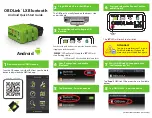
RTW DigitalMonitor 10500X-PLUS
173
E 4.3.1 What is monitored in stereo sound analyzer mode?
With the Stereo Sound Analyzer the display reads:
- Balance between L and R channels
- Display of phantom sound sources or correlation
- Display of dominant sound events
- Adjustable coordinate system (SPL or loudness)
- Total sound volume indicator
The Stereo Sound Analyzer gives you an accurately-scaled visual represen-
tation of the relative volume relationship of the stereo sound. The interaction
of sound level (loudness or sound pressure) and phase correlation are
converted into an immediately comprehensible visual image. In addition to
this, the visual display of the Stereo Sound Analyzer has been designed to
ensure that the dynamic behavior of the displays corresponds to the
subjective acoustic impression, making it possible to understand the balance
of your stereo programme immediately, at a single glance. The Stereo Sound
Analyzer display is based on the loudness (ITU BS.1771 RLB or RTW method)
or the reference sound pressure level, when the DigitalMonitor 10500X-PLUS
and the studio monitoring system are properly calibrated. The axes of the
45° rotated coordinate system use dB loudness or dB SPL scales, with a
reference mark that is also shown in the loudness and SPL displays in the
peak meters.
Graphical display of overall loudness
Vectorscope display devices often show the relationships between the
individual sound levels that make up a stereo signal with circular or pie-
slice graphics. Despite the great popularity of round shapes we have chosen
to use a combination of a polygon and bar graphs in the Stereo Sound Ana-
lyzer, because this makes it possible to display more parameters simulta-
neously and with greater clarity. The polygon is generated by combining the
displayed level values on the scales of the 45° coordinate system. When
both channel are set to the same level with a white noise signal the result is
a triangle display, the area of which is a measure of the total sound volume.
The distribution in the two quadrants shows the volume distribution in the
stereo system. In addition to this the display also takes into account the
phase correlation.
Loudness-based level control
Loudness-based level control has been recommended for some time now
for optimal adjustment of the volumes of several individual programmes.
The DigitalMonitor 10500X-PLUS supports loudness-based level control on
the basis of a defined reference sound pressure level. To use this feature,
the studios monitoring system must first be calibrated against a reference
listening sound pressure level (e. g. 85 dB(A)) with a sound level meter.
Loudness-based level control provides much more accurate and realistic
monitoring of the balance between dialog, effects and music.
E 4 Display Modes E 4.3 Stereo Sound Analyzer
Содержание DigitalMonitor 10500X-PLUS
Страница 1: ...Bedienungsanleitung Operating Manual DigitalMonitor 10500X PLUS...
Страница 8: ...RTW DigitalMonitor 10500X PLUS 8...
Страница 9: ...DigitalMonitor 10500X PLUS Bedienungsanleitung deutsch...
Страница 10: ...RTW DigitalMonitor 10500X PLUS 10...
Страница 16: ...RTW DigitalMonitor 10500X PLUS 16...
Страница 106: ...RTW DigitalMonitor 10500X PLUS 106...
Страница 117: ...RTW DigitalMonitor 10500X PLUS 117 D 8 Zeichnungen D 8 1 Abmessungen D 8 Zeichnungen D 8 1 Abmessungen...
Страница 126: ...RTW DigitalMonitor 10500X PLUS 126...
Страница 130: ...RTW DigitalMonitor 10500X PLUS 130...
Страница 131: ...DigitalMonitor 10500X PLUS Operating Manual english...
Страница 132: ...RTW DigitalMonitor 10500X PLUS 132...
Страница 138: ...RTW DigitalMonitor 10500X PLUS 138...
Страница 192: ...RTW DigitalMonitor 10500X PLUS 192...
Страница 226: ...RTW DigitalMonitor 10500X PLUS 226...
Страница 237: ...RTW DigitalMonitor 10500X PLUS 237 E 8 Drawings E 8 1 Mechanical Outlines E 8 Drawings E 8 1 Mechanical Outlines...
Страница 246: ...RTW DigitalMonitor 10500X PLUS 246...
Страница 250: ...RTW DigitalMonitor 10500X PLUS 250...
Страница 251: ...Trennseite...
















































